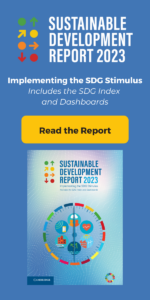Stimulating innovation for net zero
New technologies will play a vital role in achieving net zero. Getting them on stream and in widespread use fast enough to prevent climate catastrophe calls for bold and urgent action to unblock essential investment
Climate — Global

Despite heightened ambition at COP26, it is clear that the world is still moving too slowly to keep temperature rises to well below 2°C by the end of the century and avoid the very worst impacts of climate change. Extreme weather events, including record-breaking heatwaves and droughts in Europe and unprecedented flooding in Pakistan, highlight the ever more urgent need for large-scale and accelerated action to remain on track to reach net-zero greenhouse gas (GHG) emissions by 2050.
The innovation and diffusion of new technologies is at the center of achieving net zero. More broadly, innovation is urgently required for economies to improve productivity, resource efficiency, and resilience. This is imperative in economies that have faced weak growth and stagnant living standards since the financial crisis, and new pressures due to the pandemic and current energy crisis. The next wave of technological change can drive sustainable economic growth as the transition to net zero intertwines with digital transformation. But achieving this will require net zero to be embedded into national and regional growth strategies, with coordinated policies that overcome market failures and barriers to investment. It follows that to meet the interconnected Sustainable Development Goals on climate, energy, growth, and industry, we need to simultaneously increase the amount of investment and innovation in the economy, and influence its direction towards sustainability.
Investment in existing and emerging technologies
In its Net Zero by 2050 roadmap, the International Energy Agency (IEA) estimates that most global emissions reductions to 2030 will come from net-zero-aligned (or “clean”) technologies that are readily available, such as renewable energy, nuclear, electrification of transport, and improving energy efficiency. But half of the reductions to 2050 will come from technologies that are in an earlier stage of development, with further innovation required. These include advanced batteries, hydrogen electrolyzers, and direct air capture and storage (carbon dioxide removal is now considered necessary for meeting net-zero commitments).
There is reason for optimism in terms of what is possible. We have seen that clean technologies are particularly effective at generating economies of scale in production and innovation. According to the Intergovernmental Panel on Climate Change (Working Group III report on Mitigation of Climate Change), the 2010 to 2019 period has seen sustained decreases in the unit costs of solar energy (85%), wind energy (55%), and lithium-ion batteries (85%). Understanding the ultimate causes and paths of innovation trends and accelerations, and how policy can influence these, is challenging. But there is strong evidence that policies and market incentives have driven investment in renewable technology innovation, and that technology costs have declined with cumulative deployment.
Given the steep learning curves experienced in renewables, low-carbon solutions are already competitive in the electricity sector. With increasing investment, SYSTEMIQ estimates that clean technologies could become competitive in sectors representing 90% of emissions by 2030. The key question then is: how can investment be channeled such that market tipping points are reached as quickly as possible?
A coordinated policy approach can overcome barriers to investment
A general justification for government support for research and development (R&D) is the existence of knowledge spillovers, which imply that innovators are unable to fully capture all the benefits of their innovations, even with an effective system of property rights in place. This results in underinvestment relative to what society needs. Further market failures arise where imperfections in capital markets limit investment – innovative projects can be long term and payoffs uncertain. There is evidence that both of these barriers are enhanced in the case of clean technologies: where knowledge spillovers (as measured using forward citations in patents) appear to be particularly high, and where investments in early-stage technologies have been viewed by many investors as riskier than other areas.
Clearly, there are further market failures that hold back investment in the development and deployment of clean technologies. First, the GHG externality. In the absence of a robust carbon price, markets do not internalize the price of carbon emissions, thus reducing the incentive to invest in clean technologies. On the flipside, markets do not capture the societal co-benefits associated with decarbonization, such as cleaner air. In addition, because net zero requires the transformation of energy, transport, and urban systems, significant problems of network coordination and design need to be overcome. Issues of inadequate information on technologies and product options (needed to guide decisions of consumers, investors, and workers through the transition) are also important.
While specific policies to fix these market failures are required, strong path dependencies in the production, deployment, and diffusion of innovation make it hard to shift to clean technologies and sustainable growth quickly without a coordinated set of mutually enforcing policies and institutions being in place. This is a key insight stemming from the economics literature on endogenous directed technical change, which concludes that optimal policy consists of both carbon taxes and other levers, including public support for clean R&D to move economies onto a sustainable growth path.
Increasing public investments in clean R&D
Given the urgency of the climate challenge, it is clear that more R&D is required to develop new technologies and improve existing ones. Putting a number to this is challenging: expenditure on R&D is one measure of innovation input, and the extent to which it translates to the desired solutions is uncertain (and likely to vary across technology types and context). But we know that publicly funded R&D, in innovative economies, is important for generating innovation spillovers and for crowding in private-sector investment. Examining the data on public R&D spending, by technology area, over time, can help size the gap.
Data from the IEA shows that public investment in energy research, development, and demonstration in the US (the largest spender among IEA member countries) has been on an upward trajectory since 2017. But, at USD 9 billion in 2021, this is lower than levels seen around 1980.
There is a similar pattern in the UK (the fourth largest spender, at USD 1.3 billion in 2021). However, the rise in recent years is largely accounted for by nuclear rather than renewables (which saw a larger rise during the 2000s). Overall, publicly funded energy R&D accounts for 0.04% of gross domestic product (GDP), only a third of that spent on health (at 0.12% of GDP, according to data from the Organisation for Economic Co-operation and Development).
Considering comparative advantage and likely returns to innovation across countries and technology types can also help inform places where investments in R&D should be increased. For example, a recent UK analysis of patenting (a standard measure of innovation output) with my colleagues Ralf Martin, Dennis Verhoeven and Arjun Shah shows that the UK specializes in a number of clean technologies including offshore wind, ocean energy, and carbon capture, utilization, and storage. These are areas where the economic returns to public investments (taking into account both private returns and spillovers to other innovators) are particularly high. Given patterns of regional specialization, investments in these technologies have the potential to contribute to more regionally balanced growth. There is therefore a strong case for targeting support and investment towards these areas, on both climate and growth grounds.
There is a growing evidence base in terms of the specific polices and frameworks needed to engage the private sector in innovation (see also Popp and others’ review of the literature on environmental innovation). Environmental regulations, public grants, and tax incentives for R&D are key. So too are measures to foster collaboration between universities and industry. Together, these will help to create and de-risk business models for the commercialization of new technologies. More fundamentally, they will set the clear direction of travel on policy to reduce uncertainty for businesses.
A sense of urgency and public support
Before the pandemic, it was common to refer to the World Wars as an analogy of what is required to tackle the climate crisis. These were times when countries urgently mobilized resources for a shared purpose. COVID-19 now provides a recent example of a global crisis that necessitated rapid, international action. The development and deployment of vaccines, take-up of new technologies, behavior change, and policy responses that enabled this (including support for businesses and individuals that needed it) demonstrate that today’s societies can make rapid changes when we recognize clearly the need to do so and when incentives are aligned with the urgency of the situation.
Public understanding and support are crucial for the ability of policymakers and businesses to deliver net zero and its many co-benefits. Protecting and building this must therefore be a priority, particular in the current energy (and cost of living) crisis being faced in many economies that rely on gas supplies disrupted by Russia’s invasion of Ukraine.
The energy and climate crises require the same solution: accelerating the transition to renewables, improving energy efficiency, reducing waste, and protecting those that are most vulnerable. COP27 occurs at a crucial time. Reflecting this urgency in coordinated approaches to generate the required investments must be a priority, converting COP26’s ambition to delivery.







